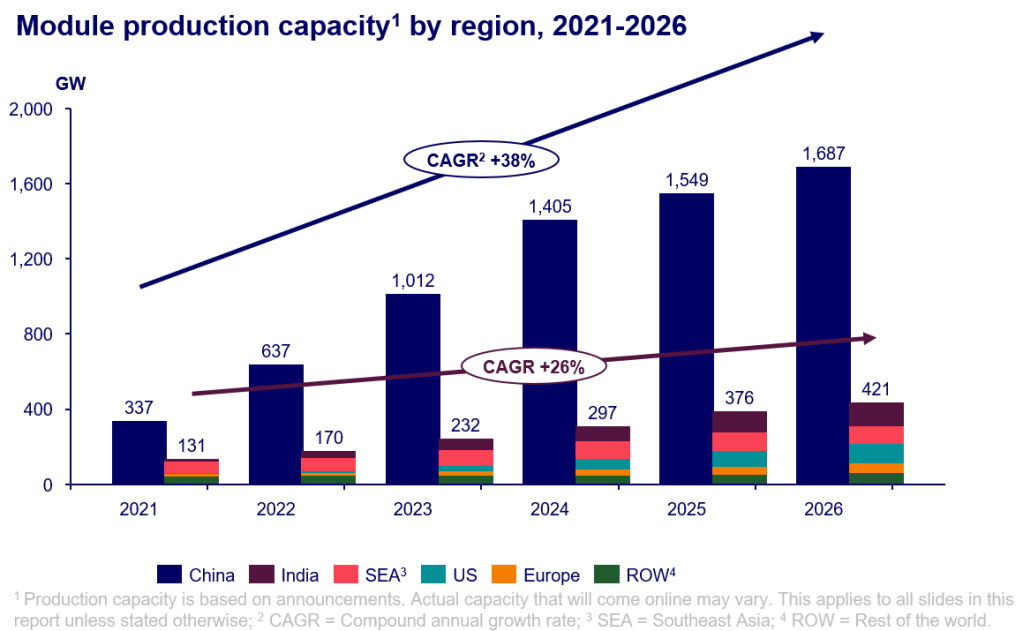
China’s astounding solar manufacturing expansion is going to dominate the global solar supply chain – and widen the technology and cost gap.
China invested over $130 billion into the solar industry in 2023. As a result, it will hold more than 80% of the world’s polysilicon, wafer, cell, and module manufacturing capacity from 2023 to 2026, according to Wood Mackenzie‘s recent report, “How will China’s expansion affect global solar module supply chains?”
China is projected to bring more than 1 terawatt (TW) of wafer, cell, and module capacity online by 2024. That means the country’s capacity is sufficient to meet annual global demand through 2032, based on Wood Mackenzie’s forecasts of annual demand growth.

Huaiyan Sun, senior consultant at Wood Mackenzie and author of the report, said:
China’s solar manufacturing expansion has been driven by high margins for polysilicon, technology upgrades, and policy support.
And despite strong government initiatives for developing local manufacturing in overseas markets, China will still dominate the global solar supply chain and continue to widen the technology and cost gap with competitors.
China is the world’s solar powerhouse…
The US, Europe, and other markets have launched unprecedented solar manufacturing pushes. The US and India combined have announced more than 200 gigawatts (GW) of planned module capacity since 2022. The Inflation Reduction Act (IRA) drove the surge in the US, and the Production Linked Incentive (PLI) increased solar module capacity in India.
But Wood Mackenzie says they’re still not cost-competitive compared to China’s supply. According to the report, a module made in China is 50% cheaper than one produced in Europe and 65% cheaper than the US.
Sun adds, “Despite considerable module expansion plans, overseas markets still cannot eliminate their dependence on China for wafers and cells in the next three years.”
When it comes to tech innovation, China will continue to lead. It’s announced it will build more than 1,000 GW of N-type cell capacity, the next-gen technology after P-type. (N-type cells have longer carrier life and higher efficiency.) That’s 17 times more N-type cell capacity than the rest of the world.
… But not everything is coming up roses
There’s intense competition and oversupply in the Chinese market, and that’s not expected to change anytime soon. As a result, some expansion plans are being canceled.
Old production lines that manufacture lower-efficiency products, such as the P-type and M6 cells, are where the oversupply problem is occurring. Demand for P-type cells began to decline this year, and Wood Mackenzie analysts expect it to be only 17% of supply by 2026.
Sun said that “more than 70 GW of capacity in China has been terminated or suspended in the past three months.” As a result, China’s solar manufacturing industry is going to have a rough time. Module manufacturers will be forced to take orders at a loss, reduce capacity, or even shut down entirely.
Read more: Solar panel exports are breaking records – now let’s install them
Photo: China News Service
To limit power outages and make your home more resilient, consider going solar with a battery storage system. In order to find a trusted, reliable solar installer near you that offers competitive pricing, check out EnergySage, a free service that makes it easy for you to go solar. They have hundreds of pre-vetted solar installers competing for your business, ensuring you get high quality solutions and save 20-30% compared to going it alone. Plus, it’s free to use and you won’t get sales calls until you select an installer and you share your phone number with them.
Your personalized solar quotes are easy to compare online and you’ll get access to unbiased Energy Advisers to help you every step of the way. Get started here. – ad*
FTC: We use income earning auto affiliate links. More.



Comments